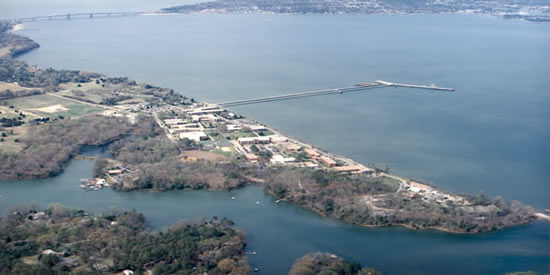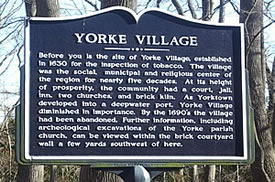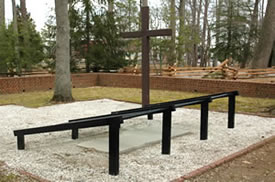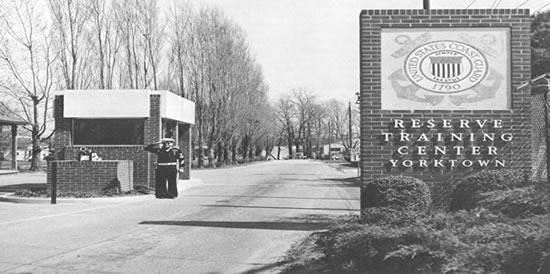Training Center Yorktown's History
Training Center Yorktown occupies the easternmost tip of Virginia's historical triangle, formed by Jamestown, Williamsburg, and Yorktown. In 1629, the Virginia Council issued an order calling for the settlement of the south bank of the Charles (now York) River. The following year, Governor Sir John Harvey was given a land patent of 752 acres at Wormley Creek establishing Yorke Village.

Training Center Yorktown on the York River
The designation of Yorke Village as a marine port in 1633 demonstrated the importance of maritime commerce to these first settlers. Although the exact size and population of Yorke village is not known, history clearly indicates that during a major portion of the 1600's it served as the social, municipal, and religious center of the portion of the York River area. The only remaining feature from either of the two churches from Yorke Village is the gravestone of Major William Gooch, who died in October 1655. The Gooch grave is one of the oldest legible tombstones in the New World. The decline and eventual abandonment of Yorke village coincided with the upriver development of Yorktown as a superior deepwater port in the late 1690's.

Historical Marker
|

Gravestone of Major William Gooch
|
Yorktown's moment in history began September 28, 1781, when a group of Colonial and French soldiers set out from Williamsburg to lay siege to the British Army that had fortified the seaport hamlet. Twenty-one days later, Washington had defeated Cornwallis and his British regiments. The surrender was signed at the Moore House, located just outside the entrance to the Training Center.

Siege of Yorktown 1862
During the Civil War, this area became the site of fortifications established by the Army of the Potomac. These fortifications served as part of the siege line established around Yorktown. Once the Union Army was in control of the Peninsula, these trenches became defensive protection in the event of a Confederate attack up the York River.
|
|
|
|
Civil War Photographs taken on Yorktown Battlefield
|
In 1917, the United States Navy purchased 400 acres of the Yorktown, Virginia, peninsula to serve as a fuel depot. In 1942, the Navy established its Mine Warfare School on a portion of this land. The Coast Guard took possession of the Mine Warfare School site in 1959, and the "Reserve Training Center" (RTC), as it was originally called, was officially commissioned on the 3rd of July the same year. The original purpose of RTC was to serve as the home for the Coast Guard's Officer Candidate School and a large summer training program for Reservists.

Reserve Training Center Yorktown 1965
Museums and Additional Historic Information
Living History. You are in Virginia's historic triangle (Jamestown, Yorktown and Williamsburg). The area includes North America's original English-speaking settlements and pivotal battlefields from both the American Revolutionary and Civil Wars. Visit the historical sites and small historical museums on base and the superb local parks, visitor's centers and museums for a truly rich historical experience.
Old Yorke Village - Church Site. The village was settled in 1630 and quickly became a key religious, social, and municipal center until it was eventually replaced by Yorktown (upriver) in the late 1690's. Take a stroll to the village's site to view the gravestone of Major William Gooch (died 1655) one of the oldest legible tombstones in the New World. Artifacts from the site are also displayed in Thayer Hall.
Admiral Benkert Maritime Museum. Located in Hamilton Hall's entrance foyer, the area features exhibits and examples of merchant marine equipment, vessels, and memorabilia. The Marine Investigation and Safety School maintains the exhibit area.
American Revolutionary & Civil Wars. American, French, and British troops fought the last great battle of the American Revolution at Yorktown in 1781. The siege resulted in the defeat of the British forces under Cornwallis and secured the fledgling nation's freedom. Less than 100 years later Civil War soldiers fought here. The siege trenches and defensive fortifications from those old campaigns are still visible around the base and in the local area.
Download Plug-Ins: Some of the links on this page require a plug-in to view them. Links to the plug-ins are available below.
Adobe Acrobat Reader (PDF)
Last Modified 12/21/2016